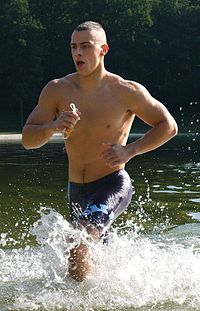
Photo from wikipedia
Hunger and satiety are controlled by several physiological mechanisms, including pancreatic and gastrointestinal hormones. While the influence of exercise and fasting have been described individually, in relation to these hormones,… Click to show full abstract
Hunger and satiety are controlled by several physiological mechanisms, including pancreatic and gastrointestinal hormones. While the influence of exercise and fasting have been described individually, in relation to these hormones, there is a paucity of work showing the effects of the two modalities (fasting and exercise) combined. Twenty healthy adults (11 males, 9 females) completed both conditions of this study, each consisting of a 36-h water-only fast. One of the fasts began with treadmill exercise, and the differences between the conditions on various appetite hormones were measured every 12 h. The difference in the area under the curve between conditions for ghrelin was 211.8 ± 73.1 pg/mL (F = 8.40, p < 0.0105), and, for GLP-1, it was −1867.9 ± 850.4 pg/mL (F = 4.82, p < 0.0422). No significant differences were noted for areas under the curve between conditions for leptin, PP, PYY, insulin, or GIP. Initiating a fast with exercise lowers ghrelin concentrations and elevates GLP-1 concentrations. Given that ghrelin elicits feelings of hunger and GLP-1 signals feelings of satiety, adding exercise to the beginning of a fast may reduce some of the biological drive of hunger, which could make fasting more tolerable, leading to better adherence and more significant health outcomes.
Journal Title: Nutrients
Year Published: 2023
Link to full text (if available)
Share on Social Media: Sign Up to like & get
recommendations!